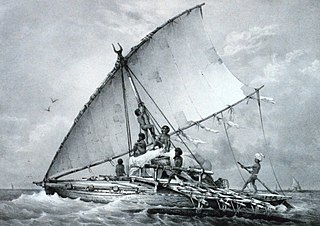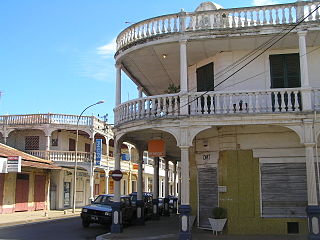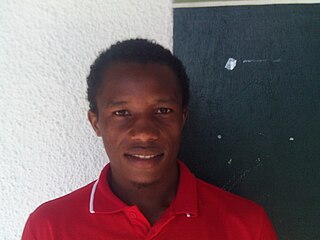Related Research Articles

Madagascar, officially the Republic of Madagascar, and previously known as the Malagasy Republic, is an island country in the Indian Ocean, approximately 400 kilometres off the coast of East Africa across the Mozambique Channel. At 592,800 square kilometres (228,900 sq mi) Madagascar is the world's second-largest island country, after Indonesia. The nation comprises the island of Madagascar and numerous smaller peripheral islands. Following the prehistoric breakup of the supercontinent Gondwana, Madagascar split from the Indian subcontinent around 88 million years ago, allowing native plants and animals to evolve in relative isolation. Consequently, Madagascar is a biodiversity hotspot; over 90% of its wildlife is found nowhere else on Earth. The island's diverse ecosystems and unique wildlife are threatened by the encroachment of the rapidly growing human population and other environmental threats.

The history of Madagascar is distinguished clearly by the early isolation of the landmass from the ancient supercontinent containing Africa and India, and by the island's late colonization by human settlers arriving in outrigger canoes from the Sunda islands and from East Africa. These two factors facilitated the evolution and survival of thousands of endemic plant and animal species, some of which have gone extinct or are currently threatened with extinction due to the government not allocating resources to help the growing population, causing many people to resort to harmful environmental practices as a way of survival. Over the past two thousand years the island has received waves of settlers of diverse origins including Austronesian, Bantu, Arab, South Asian, Chinese and European. The majority of the population of Madagascar today is a mixture of Austronesian and Bantu settlers. Despite popular belief, there has been no genetic input from Arabs or Indians, although one tribe, the Antemoro, claims descent from Somali Arab traders. There's also European and Middle eastern paternal ancestry

This article is about the demographic features of the population of Madagascar, including population density, ethnicity, education level, health of the populace, economic status, religious affiliations and other aspects of the population.

The economy of Madagascar is a market economy and is supported by Madagascar's well-established agricultural industry and emerging tourism, textile and mining industries. Malagasy agriculture produces tropical staple crops such as rice and cassava, as well as cash crops such as vanilla and coffee. Madagascar's wealth of natural resources supports its sizable mining industry. Additionally, Madagascar's status as a developing nation exempts Malagasy exports from customs protocol in some areas, notably the United States and European Union. These exemptions have supported the growth of the Malagasy textile industry. Despite Madagascar's natural resources and developing industries, the 2009 Malagasy political crisis—considered by the international community to be an illegal coup—deterred foreign investments in Madagascar and caused the Malagasy economy to decline. Foreign investments have resumed following the resumption of elections in early 2014. At 2018, Madagascar is one of the world's fastest-growing economies.

Antsiranana, named Diego-Suarez prior to 1975, is a city in the far north of Madagascar. Antsiranana is the capital of Diana Region. It had an estimated population of 115,015 in 2013.

The Madagascar national football team, nicknamed Barea after the island's zebu, is the national team of Madagascar and is controlled by the Malagasy Football Federation. It has never qualified for the finals of the World Cup. It took part in its first Africa Cup of Nations in 2019. Among its biggest wins was a 1–0 home victory over Egypt in the qualification rounds of the 2004 Africa Cup of Nations until being surpassed by a recent shocking 2–0 win over Nigeria in the group stage of the 2019 Africa Cup of Nations. Reflecting the official name of the country at the time, the team was known as the Malagasy Republic national football team between 1958 and 1975.

The Central Bank of Madagascar is the central bank of Madagascar.

Malagasy cuisine encompasses the many diverse culinary traditions of the Indian Ocean island of Madagascar. Foods eaten in Madagascar reflect the influence of Southeast Asian, African, Indian, Chinese and European migrants that have settled on the island since it was first populated by seafarers from Borneo between 100 CE and 500 CE. Rice, the cornerstone of the Malagasy diet, was cultivated alongside tubers and other Southeast Asian staples by these earliest settlers. Their diet was supplemented by foraging and hunting wild game, which contributed to the extinction of the island's bird and mammal megafauna. These food sources were later complemented by beef in the form of zebu introduced into Madagascar by East African migrants arriving around 1,000 CE.

The culture of Madagascar reflects the origins of the people Malagasy people in Southeast Asia and East Africa. The influence of Arabs, Indians, British, French and Chinese settlers is also evident. The most emblematic instrument of Madagascar, the valiha, is a bamboo tube zither carried to the island by early settlers from southern Borneo, and is very similar in form to those found in Indonesia and the Philippines today. Traditional houses in Madagascar are likewise similar to those of southern Borneo in terms of symbolism and construction, featuring a rectangular layout with a peaked roof and central support pillar. Reflecting a widespread veneration of the ancestors, tombs are culturally significant in many regions and tend to be built of more durable material, typically stone, and display more elaborate decoration than the houses of the living. The production and weaving of silk can be traced back to the island's earliest settlers, and Madagascar's national dress, the woven lamba, has evolved into a varied and refined art. The Southeast Asian cultural influence is also evident in Malagasy cuisine, in which rice is consumed at every meal, typically accompanied by one of a variety of flavorful vegetable or meat dishes. African influence is reflected in the sacred importance of zebu cattle and their embodiment of their owner's wealth, traditions originating on the African mainland. Cattle rustling, originally a rite of passage for young men in the plains areas of Madagascar where the largest herds of cattle are kept, has become a dangerous and sometimes deadly criminal enterprise as herdsmen in the southwest attempt to defend their cattle with traditional spears against increasingly armed professional rustlers.
Football is, along with Rugby union, one of the most popular sports in the African island nation of Madagascar. The sport is governed in the country by the Malagasy Football Federation.

Mamy Gervais Nirina Randrianarisoa is a Malagasy footballer who plays as a centre back for Réunionnais club JS Saint-Pierroise and the Madagascar national team.

Faneva Imà Andriatsima is a Malagasy professional footballer who plays as a forward.

Malagasy is an Austronesian language and the national language of Madagascar. Malagasy is the westernmost Malayo-Polynesian language, brought to Madagascar by the settlement of Austronesian peoples from the Sunda islands around the 5th century CE. The Malagasy language is one of the Barito languages and is most closely related to the Ma'anyan language, still spoken on Borneo to this day. Malagasy also includes numerous Malay and Javanese loanwords, from the time of the early Austronesian settlement and trading between Madagascar and the Sunda Islands. After c. 1000 CE, Malagasy incorporated numerous Bantu and Arabic loanwords, brought over by new settlers and traders.

The Malagasy language of Austronesian origin, is generally spoken throughout the island. The official languages of Madagascar are Malagasy and French. Madagascar is a Francophone country, and French is spoken among the educated population of this former French colony. Including second-language speakers, there are more speakers of Malagasy than French in Madagascar.
Ma'anyan or Ma'anjan or Maanyak Dayak is an Austronesian language belonging to the East Barito languages. It is spoken by about 150,000 Ma'anyan people living in the province of Central Kalimantan, Indonesia. It is closely related to the Malagasy language spoken in Madagascar.
Njiva Tsilavina Martin Rakotoharimalala is a Malagasy football winger.
Rayan Ny Aina Arnaldo Raveloson is a Malagasy professional footballer who plays as a midfielder for Major League Soccer club LA Galaxy. He also holds a French passport as he was raised in Réunion, where his mother is from.
The Malagasy Chess Championship is organized by the Madagascar Chess Federation, which was initially founded in 1970 and most recently revived in 2008 after a decade of inactivity. The national championship was first held in 1994. There is also a separate Malagasy Women's Chess Championship which was first held in 2009.
The Council of Christian Churches in Madagascar (FFKM) is an inter-church organization in Madagascar founded in 1980. It comprises the four main religious denominations in the country: the Roman Catholic Church (EKAR), the Church of Jesus Christ in Madagascar (FJKM), the Malagasy Episcopal Church, and the Malagasy Lutheran Church (FLM). The FFKM is headquartered in Antananarivo, and its member denominations represent more than 10 million members. The FFKM currently celebrates its 40th anniversary.

The Mahorese culture is characterized by the diversity of the cultural practices of its inhabitants.
References
- 1 2 "Antsary (Achards citron - Recette Malagasy), lasary gasy". Ma Cuisine - By OnyRD (in French). 2017-09-11. Retrieved 2019-06-16.
- ↑ Chan Tat Chuen (2010), p. 39
- ↑ "Les secrets d'un lasary malagasy réussi comme au pays !". Malagasy club de France (in French). 2015-10-15. Retrieved 2019-06-16.
- ↑ Kennedy, Joe (2015-10-16). "Incredible Edibles: 10 Foods From Madagascar That You Have To Try". AFKTravel. Retrieved 2019-06-12.